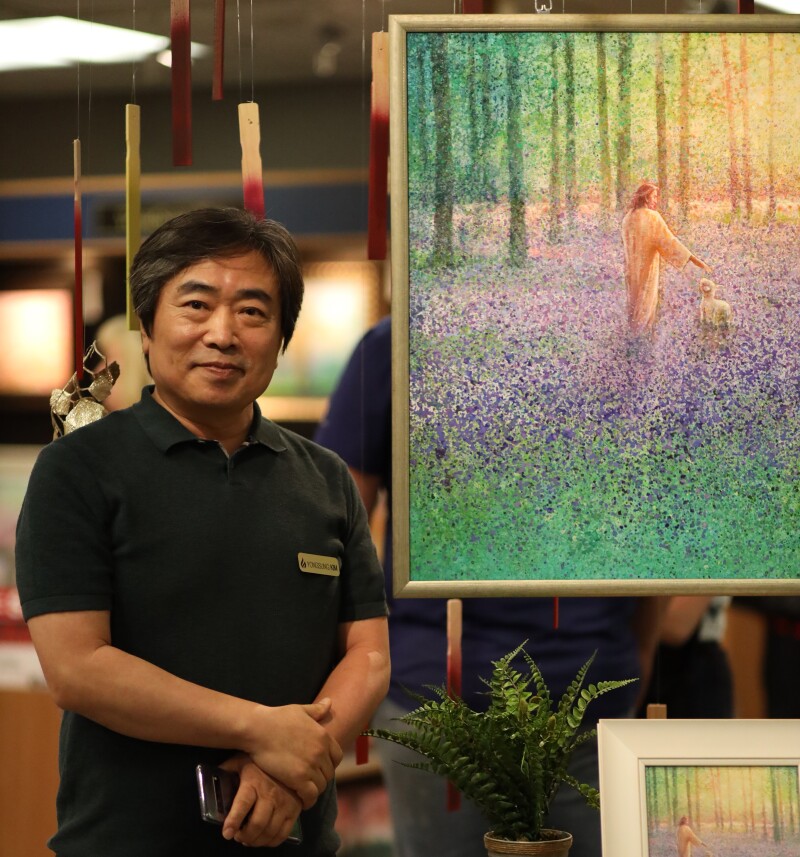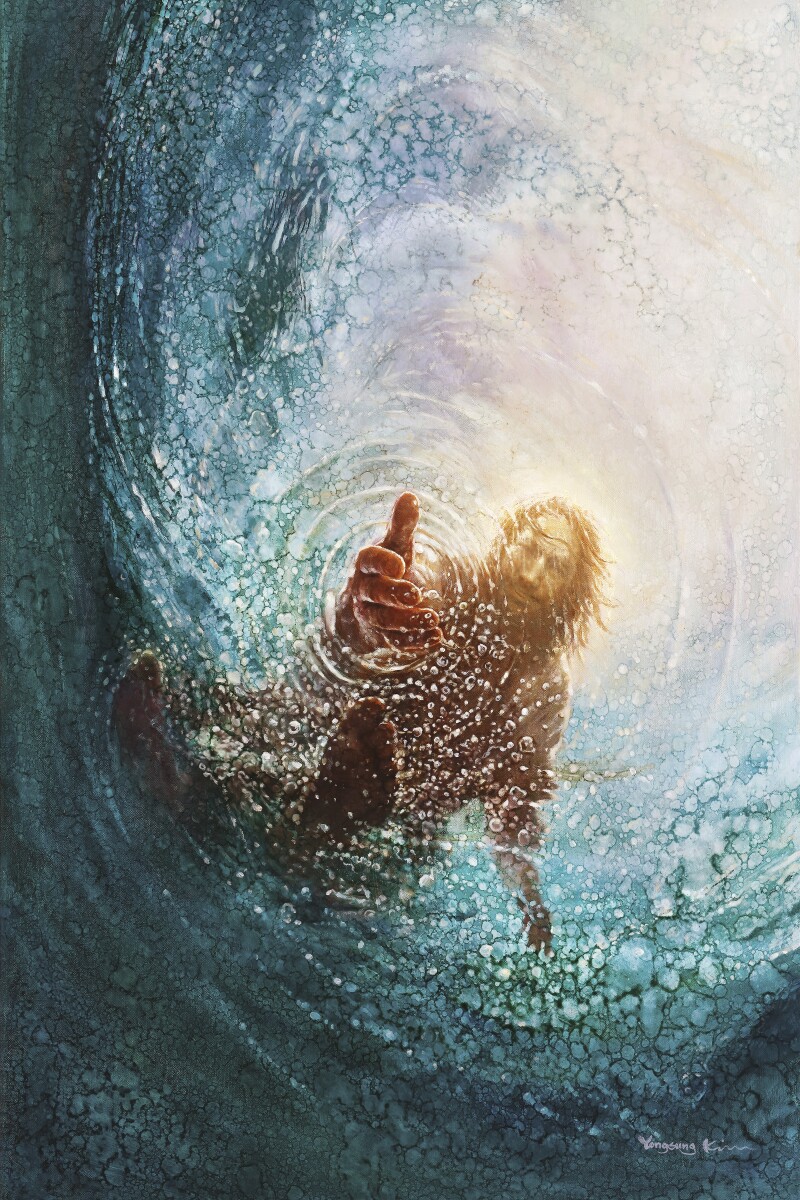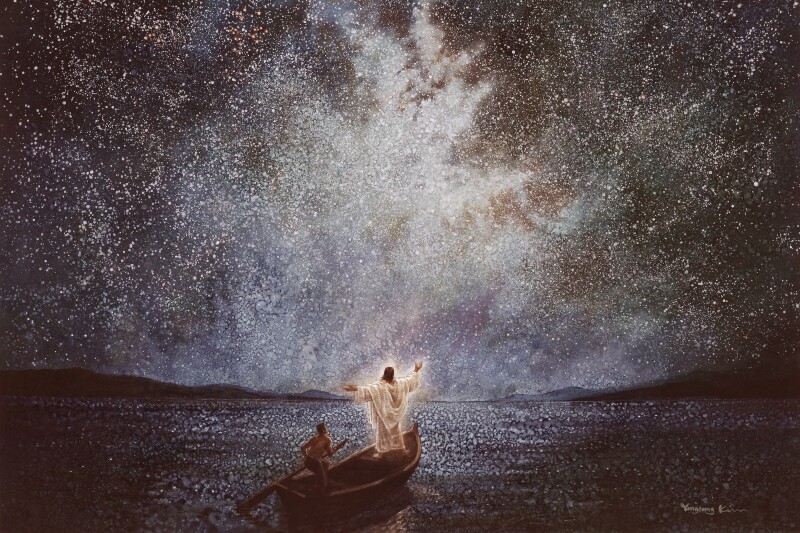
The late beloved public-TV painter Bob Ross was famously quoted as saying, “Anything we don’t like, we’ll turn it into a happy little tree or something; we don’t make mistakes, we just have happy accidents.”
Across the ocean is another artist with an eye for recognizing and embracing art’s joyful possibilities. A native of South Korea and a member of South Korea’s Church of Christ, Yongsung Kim paints religious art that often depicts happy sheep and a happy Jesus. And their happiness is no accident—in fact, Yongsung’s choice to paint joyful subjects is very intentional.
“I like to draw the Christ who is beautiful, who is smiling, and who is happy because I like to help people who are suffering heal. I like to share my talents to help people recover from their pains,” Yongsung explains. “That’s why I decided to draw the happy Christ.”
And it’s that happy Christ that has drawn Latter-day Saints to Yongsung’s art. His paintings have been featured in Latter-day Saint Church magazines and in prominent places in the Gospel Library app. And in October 2018, Bonnie H. Cordon, then Young Women General President, shared several of Yongsung’s paintings during her general conference address. His use of bright, vibrant colors and his ability to convey joy in every detail have endeared Yongsung’s paintings to members of the Church in a remarkable way.
Answering the Call
Yongsung was born in Jeongeup, a South Korean village that was void of a religious presence. But in middle school, his family moved to the capital city of Seoul. In Yongsung’s second year of high school, he was invited by Christian missionaries to attend church and he soon became a believer.
Having grown up in a very rural, mountainous village far from the city, Yongsung is a lifelong lover of nature. From a young age, he expressed his passion for the beauty he saw in the world by drawing cartoons. This gradually expanded into painting when he was in middle school.
As a new Christian at age 18, Yongsung was in the mountains when he decided to offer a prayer to ask God what he should do with his future.
“God answered that prayer, ‘Remember that I gave you talent, and I want to use your talent—and I’d like to be glorified with your talent,’” Yongsung recalls. That same day he lay on the ground and looked up at the sky full of moving clouds, praising God for the answer to his prayer.
“I like to share my talents to help people recover from their pains.”
“All of a sudden, the movement of the clouds to me was like Christ on the cross. I still cannot forget the image of the Christ in the middle of the clouds. So that was my very first portrayal of Christ,” Yongsung recalls.
The Happy Jesus
With the answer to his prayer, Yongsung knew that God wanted him to use his talent. But he knew he’d need to differentiate his art from other artists’ works to create truly impactful images. Yongsung didn’t know what his unique approach would be—that is, until he was walking the aisles of a Christian art supply store and noticed something about each of the portrayals of Christ.
“In all the pictures that I was able to see inside the shop, Christ was portrayed as suffering and in pain. But Christ is happy and handsome and gives us pleasure, so why do we not have Christ portrayed smiling? And all of a sudden inside of myself, I felt something very special springing out,” he recalls.
Yongsung is not alone in noticing somber depictions of Christ as the norm. On an All In podcast episode, Elder Lynn G. Robbins of the Presidency of the Seventy talked about how Christian art has traditionally depicted Jesus Christ as one “acquainted with grief” (Isaiah 53:3). But Elder Robbins recalls Elder Neal A. Maxwell once teaching that “acquainted with grief” refers more to Christ taking upon Himself our sins, our burdens, and our grief, and not to His day-to-day countenance. Elder Robbins then continues, “Can you imagine how excited He would be each morning to awaken, knowing the impact He would have on many lives that day—bringing sight to the blind, hearing to the deaf, helping the lame to walk, and performing miracles in so many other ways? I think He would have been the happiest person ever.”
For Yongsung, focusing on a joyful Jesus would come to transform not only his art, but also his outlook on life. As a boy, Yongsung describes himself as depressed; he often felt inferior and struggled in school. To him, life was lonely and bleak, with no hope for the future. But Jesus Christ had changed everything.
“Jesus said to me, ‘I love you. I love you more than anything in this world, and I will give my life for you and take responsibility for your future,’” he recalls.
As he began painting the joyful Jesus he’d come to love, Yongsung felt renewed purpose and a very clear vision for what he was meant to do with his life. In fact, He recalls a prayer in which he vowed fervently to God that He would answer the call to paint.
▶ You may also like: How Walter Rane’s masterpieces have dramatically changed Latter-day Saint art
At the time, Yongsung knew that religious paintings would not cover his living expenses, so he focused on drawing and selling replicas of famous paintings and movie posters. And later, despite never receiving professional training, he became a successful mural artist. These pursuits allowed Yongsung to support his family for many years. But after two decades, he felt pulled to take the leap and devote his art to the cause of Christ.
“I began to listen to the messages of dissatisfaction and regret that were boiling in my body,” Yongsung says. He pondered on the vow he’d made with God 20 years earlier that he would paint Jesus. He thought of God saying to him, “Didn’t you promise me? Did you not promise to do a ministry that brings glory to me through the talents I gave you?”
So at 40 years old, Yongsung began painting the Savior in earnest for the first time, and in the process he developed a painting style all his own. He began painting with oil, but he says the paintings often felt “heavy” and didn’t fit the Christ that Yongsung knew. To him, Christ was the embodiment of peace and beauty. So he started employing techniques in his oil paintings that were usually used with watercolor. He loved the new style he’d discovered—now he could paint a Savior who was “more soft and kind and meek.”
Your Place in the Masterpiece
The idea for the painting that would become Yongsung’s personal favorite—and one of his most famous—came as an answer to prayer, but he waited 10 years before getting started. The reason? He wanted to wait until he was confident he could paint the image as beautifully as he’d envisioned.
Yongsung’s vision was to depict a Savior who was not a distant, unreachable being, but a person who would come and intervene to rescue us. To portray that truth, Yongsung planned a stunningly unique approach to one of the most famous accounts from the New Testament: the Savior rescuing the Apostle Peter from the raging sea.
When he finally picked up the brush to begin, the painting came together quickly, and just three weeks later he felt he had successfully captured a feeling that people all over the world have experienced: the feeling of being rescued by the hand of God.
Scott Usher, owner of the Christian art company Havenlight, describes Yongsung’s approach in the painting: “Instead of doing a painting of Christ saving Peter, Yongsung turned around and said, ‘Why don’t I have you [the viewer] where Peter is, and Christ is saving you? You’re down beneath the surface of the water and Christ’s hand is reaching for you.’ The idea is that you are the person that Christ is interacting with, even though it might be based on a biblical story.”

The painting, titled The Hand of God (left), has had deep meaning for countless viewers. From feeling suffocated by grief after the passing of a loved one to experiencing family separation, to overcoming suicidal thoughts, Yongsung has heard many ways that people have personally identified with the painting.
“All of them said they were sinking in the water—they were drowning—but they were able to get out of the water with the power of the hand of God,” he says. “Some of them say, ‘You saved me from suicide, you saved my family, you helped me reorganize my life, or you helped me strengthen my faith.’ But I wanted to tell them that that’s not me who did so: the Christ in my picture made that possible.”
The Hand of God isn’t Yongsung’s only piece that invites the viewer to step into the painting. Calm and Stars (below) is another example: it depicts Christ in a boat with just one other person.
“It’s the calm after the storm when He was on the Sea of Galilee. But instead of [painting] a boat full of disciples, there’s only one other person on the boat, and that person is you. You are with Him,” Scott says. “You find that time and time again [with Yongsung’s art]: Christ is looking out at you, interacting with you, bringing you along with Him. That’s an important thing that Yongsung puts in his paintings. It’s this idea that all you have to do is ask, and Christ is there for you.”

Making a Way
Yongsung says his life revolves around two things: family and painting. So it was difficult when those two priorities seemed to conflict with each other early in Yongsung’s career. He wanted to paint religious art but struggled to reconcile this desire and his ability to adequately provide for his family.
He remembers a painful conversation with his wife in which she expressed that while she had seen how Yongsung’s paintings made others happy, she was struggling to find joy in them because of the financial trials they were facing. Hearing this broke Yongsung’s heart, and he began to pray, “Heavenly Father, please help me help my wife become happy.”
Looking back, Yongsung says he wasn’t even sure if he believed his prayer would work, but years later, he can see that it did. Shortly thereafter, Yongsung began to have opportunities to expand the reach of his art, and the financial issues that had plagued his family were resolved.
For example, a Havenlight employee saw Yongsung’s art on social media and invited him to the US to experience Brigham Young University’s Women’s Conference in 2016, hoping the trip would encourage Yongsung to sell his art with the company. He hesitated, however, because he wasn’t sure what to expect from members of a church that was not his own, and he didn’t know if they would appreciate his art in the way that he hoped. But he accepted the invitation and displayed some of his art at BYU—and was amazed by the reactions he received. Many women were brought to tears over seeing such a joyful Jesus and wanted to hug Yongsung and tell him how much the art meant to them.
“I don’t think he’d really ever felt someone connect to his art in the way that these women were connecting to his artwork,” Havenlight’s Gina Bagley says.
“It was a magical time for him. He had been working so hard to try to make a living and do what he needed to do, and he found so much joy in these people relating to his artwork.”
Gina later invited Yongsung to bring more of his original paintings from South Korea to an art show in Utah and was touched when she saw him sell the original The Hand of God to a Latter-day Saint family.
“He interviewed the family and felt really good that it would be a good home,” she recalls. “[With] his love for what he did and his love for the Lord, he just wanted to make sure that his ‘child’ got placed in a home that was good and wholesome.”
From his depiction of Jesus Christ reaching to save a drowning soul to his paintings of the Good Shepherd caring for His sheep, Yongsung’s art captures a Savior who is always looking for ways to rescue and bring His sheep home. His works also remind us that the Savior’s fold is not intended to be a burdensome place but instead a joyful home—a joy that is reflected in the happy sheep in his paintings. Gina says that enough people were intrigued by the gently smiling sheep that she finally asked Yongsung why he paints them that way. His answer?
“Are we not His sheep? Does He not want us to be happy?”
Gina says that the idea of being the Savior’s sheep “represents something different to me than it ever has before. He cares for us, He takes care of us, He loves us, and He wants us to be happy. So when I see a field of sheep that are smiling [in Yongsung’s paintings], it’s endearing to me because I picture myself being one of those.”
Find more of Yongsung Kim’s artwork at Deseret Book stores and online at DeseretBook.com.
Editor’s note: Yongsung Kim was interviewed with the assistance of an interpreter.




